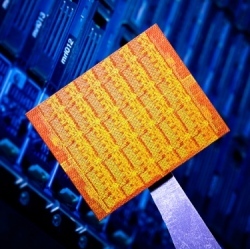
An inventor used the same principles of an integrated circuit to develop a ‘biochip’ that can perform nearly 10,000 independent simultaneous measurements – orders of magnitude above and beyond pipetting scientists in the lab. The chip is already being used to perform basic research and to discover new drugs. For his ingenuity, the chip’s inventor was recently awarded the $500,000 Lemelson-MIT prize for exceptional innovators.
The chip contains tens of thousands micromechanical pumps and valves that move nanoliter volumes of liquid through microfluidic channels in a coordinated manner. With its multitude of working parts, an experiment that would normally take 18,000 steps and a week to perform could be completed with the chip in just three hours and in just 200 steps.
The inventor of the chip, Stephen Quake, is a professor of bioengineering and applied physics at Stanford University where he studies microfluidic large-scale integration. The prodigious professor’s work has thus far led to the creation of four companies and 82 patents. He co-founded San Francisco-based Fluidigm Corp in 1999 to sell the chip. Labs are already using the chip to grow proteins into the crystalline arrangements necessary for studying protein structure. The structures for both the Ebola virus and the H5N1 Influenza virus were solved using the chip.
Companies and researchers could use the chip to run high-throughput, massively-parallel testing of molecules. The chip has been used to study transcription factors, proteins that control gene expression, by measuring how strongly the transcription factors bind to different DNA sequences. A strong bond implies that the assayed transcription factor regulates genes with that DNA sequence.
From the Quake lab website, presumably a rudimentary schematic of the chip.
Outside the research lab, drug developers are using the chip for drug discovery. For the hepatitis C virus to proliferate one of its proteins needs to bind RNA in a specific way. Quake used his biochip to screen 1,200 small molecules to see if any of them inhibited the protein-RNA interaction. They found 14, and the findings were used to develop a drug that then went on to clinical trials. The chip could employ this type of strategy to discover potential drugs to treat many more diseases, including cancer.
Like another chip developed last year to test for HIV, Quake’s chip also has diagnostic value. Quake has published proof of concept studies showing that the chip can be used as a non-invasive prenatal test to screen for certain gross chromosomal abnormalities. It measures the fetal DNA that is present in the mother’s blood during pregnancy to detect trisomy 21 (Down’s syndrome), trisomy 18 (Edward syndrome), and trisomy 13 (Patau syndrome). Earlier this year Quake launched Verinata Health to make this screen available to pregnant women.
Not only does the microfluidic chip resemble the microchip, but it owes its conceptual origins to its electronic equivalent. In the following video from a 2011 TEDxCaltech talk, Quake explains how the integrated circuit, which was originally created to perform computations but soon shown to be useful for many other applications, inspired him to ask if the biochip could follow the a similar path.
